BMW M52 Straight-6 Petrol Engine
From 1994 to 2000
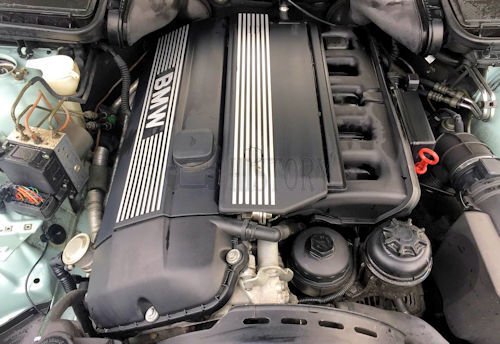
The BMW M52 is a straight-6 DOHC piston engine which was produced from 1994-2000. It was released in the E36 320i, to replace the M50. It was replaced by the M54 engine.
The M50TU adopted the cylinder clearance and bore as well as the intake camshaft VANOS camshaft adjustment system and the cylinder- selective knock control , as well as crankshaft bearing caps and vibration dampers. In the 2.0 and 2.5-liter variants of the M52, the crankshafts were taken over from the predecessor.
The most serious change compared to the previous BMW M50 engine concerned the engine block : while the M50 was cast iron , it was now produced in a closed-deck low-pressure chill casting, with the aluminum alloy for both the engine block and the cylinder head AlSi9Cu3 was chosen. The engine block was thus relieved by 22.7 kg (for comparison: the crankcase weight of the BMW M50 was 48 kg). The crankcase has only the opening for cylinders, oil and water channels. The housing height and the position of the fixing eyes for the attachments are identical to the gray cast iron predecessor.
Depending on the model, the engine weight of the BMW M52 engine was 158 kg (2.0 l and 2.5 l) and 163 kg (2.8 l), respectively , according to DIN 70020-A . This was achieved by a series of lightweight measures : The connecting rods were facilitated by 80 grams per piece, spring plate and bucket tappets also baconized, the chain tensioner was relieved by 60%, to the stainless steel manifold , which replaced the almost twice as heavy gray iron part. Overall, the 2.8-liter M52 engine saved 31 kg compared to the 2.5-liter M50.
Weight reduction on the example of the 2.0-l engine compared to the BMW M50
| component | Weight reduction in kg | Weight reduction in% |
|---|---|---|
| crankcase | 22.7 | 47 |
| valve train | 0.7 | 23 |
| Storage rails inlet and outlet | 0.5 | 14 |
| Connecting rod (6 ×) | 0.5 | 13 |
| Chain tensioner / rail | 0.3 | 59 |
| exhaust manifold | 3.8 | 42 |
| Ignition coils (6 ×) | 0.7 | 26 |
| Harness / battery line | 1.4 | 16 |
Although the change of the crankcase material from pearlitic gray cast iron to an aluminum alloy brought a weight advantage, but the disadvantages of the aluminum alloy (lower strength , lower modulus and thus lower stiffness and unfavorable tribological properties) had to be met by design measures. Thus, the rigidity of the was crankcase increases structurally by increasing the wall thickness and by ribs and the cylinder faces of the crankcase received a wear-reducing Nikasil - coating . This coating of Ni ckel,Ka RBID and Sil Izium is applied in an electrochemical process to the cylinder walls. Here, a special nickel alloy forms the carrier material in which the Siliziumkarbidteilchen are embedded. The result is a hard and wear-resistant surface. A disadvantage is the high sensitivity of the nickel (and its alloys) to sulfur-containing gases, d. H. the nickel sulfide formation at the grain boundaries lead to cold and red brittleness of the nickel. For the operation of nikasilbeschichteter engines therefore the use of (nowadays in Europe by desulphurization usual) sulfur-free fuel and low-sulfur engine oil recommended.
Among other things, as a result of the sulfur-containing fuel due to wear problems of the cylinder surfaces there were three crankcase variants in the production period of the M52 :
- The crankcase with the nickel dispersion coated aluminum alloy has BMW part number 11 11 1 744 658 and is cast number 1748450.0, with part number 11 11 1 744 658 first being replaced by 11 11 1 069 745 and subsequently 11 11 1 438 594
- The crankcase made of aluminum alloy with cylinder liners made of gray cast iron has the BMW part number 11 11 1 438 594 and has the cast number 1432219.9 (these crankcases were especially intended for the Anglo-Saxon market in response to the problem occurring there with M52 engines, between January 1995 and March 1998 were built)
- The cast iron crankcase ( special engine) has the BMW part number 11 11 1 433 067
Compared with its M50 predecessor, the M52 uses an aluminium block. However, North American models used iron blocks instead (except in the Z3), therefore the North American M52 is more akin to the M50TU. Like the M50TU, the M52 uses variable valve timing on the intake camshaft (called single VANOS by BMW).
In 1998, the M52TU ("technical update") was released, adding variable valve timing to the exhaust camshaft (called dual VANOS by BMW). Other upgrades included electronic throttle control (which uses a throttle cable as backup), a dual length intake manifold (called "DISA" by BMW) and revised cylinder liners.
The M52 and S52 engines were on the Ward's 10 Best Engines list from 1997 to 2000.
The S52 engine is used in USA versions of the 1996-1999 E36 M3 and the 1998-2000 Z3M. This engine is a tuned version of the M52 engine, as opposed to the S50 engine used for these cars in other markets.
Engine Data
| engine | capacity | Bore × stroke | Valves / cyl. | compression | Power at 1 / min | Torque at 1 / min | Maximum speed | year |
|---|---|---|---|---|---|---|---|---|
| M52B20 | 2.0 l (1990 cm 3 ) | 80.0 mm × 66.0 mm | 4 | 11.0: 1 | 110 kW (150 hp) at 5900 | 190 Nm at 4200 | 6500 min -1 | 09/1994 |
| M52B20TU | 2.0 l (1990 cm 3 ) | 80.0 mm × 66.0 mm | 4 | 11.0: 1 | 110 kW (150 hp) at 5900 | 190 Nm at 3500 | 6500 min -1 | 12/1997 |
| M52B25 | 2.5 l (2494 cm 3 ) | 84.0 mm × 75.0 mm | 4 | 10.5: 1 | 125 kW (170 hp) at 5500 | 245 Nm at 3950 | 6500 min -1 | 05/1995 |
| M52B25TU | 2.5 l (2494 cm 3 ) | 84.0 mm × 75.0 mm | 4 | 10.5: 1 | 125 kW (170 hp) at 5500 | 245 Nm at 3500 | 6500 min -1 | 03/1998 |
| M52B28 | 2.8 l (2793 cm 3 ) | 84.0 mm × 84.0 mm | 4 | 10.2: 1 | 142 kW (193 hp) at 5300 | 280 Nm at 3950 | 6500 min -1 | 01/1995 |
| M52B28 | 2.8 l (2793 cm 3 ) | 84.0 mm × 84.0 mm | 4 | 10.2: 1 | 141 kW (192 hp) at 5300 | 275 Nm at 3950 | 6500 min -1 | 03/1997 |
| M52B28TU | 2.8 l (2793 cm 3 ) | 84.0 mm × 84.0 mm | 4 | 10.2: 1 | 142 kW (193 hp) at 5500 | 280 Nm at 3500 | 6500 min -1 | 03/1998 |
| S52B32 / US | 3.2 l (3152 cm 3 ) | 86.4 mm x 89.6 mm | 4 | 10.5: 1 | 179 kW (243 hp) at 6000 | 320 Nm at 3800 | 6500 min -1 | 1996 |
M52 stands for the basic engine, B20 / B25 / B28 denotes the fuel type (B = petrol) and the displacement (eg 25 = 2.5 liters / 28 = 2.8 liters) and "TU" indicates the technically revised Engines.
Data Valve Control
| engine | capacity | motor control | Valve lift I / O in mm | Opening angle ° KW I / O | VANOS | Spread inlet ° KW | Spread outlet ° KW |
|---|---|---|---|---|---|---|---|
| M52B20 | 2.0 l (1990 cm 3 ) | MS41.0 | 9.0 / 9.0 | 228 ° / 228 ° | E 1 | 85 ° to 110 ° | -105 ° |
| M52B25 | 2.5 l (2494 cm 3 ) | MS41.0 | 9.0 / 9.0 | 228 ° / 228 ° | E 1 | 85 ° to 110 ° | -105 ° |
| M52B28 | 2.8 l (2793 cm 3 ) | MS41.0 | 9.0 / 9.0 | 228 ° / 228 ° | E 1 | 90 ° to 115 ° | -105 ° |
| Engine | Displacement | Power | Torque | Redline | Bore | Stroke | CR | Year |
|---|---|---|---|---|---|---|---|---|
| M52B20 | 1,991 cc (121 cu in) | 110 kW (150 bhp) @ 5900 |
190 N·m (140 lb·ft) @ 4200 |
6500 | 80 mm (3.1 in) | 66 mm (2.6 in) | 11.0 | 1994 |
| M52TUB20 | 110 kW (148 hp) @ 5900 |
190 N·m (140 lb·ft) @ 3500 |
6500 | 80 mm (3.1 in) | 66 mm (2.6 in) | 11.0 | 1998 | |
| M52TUB24 | 2,394 cc (146 cu in) | 135 kW (181 hp) @ 5800 |
240 N·m (180 lb·ft) @ 3600 |
6500 | 84 mm (3.3 in) | 72 mm (2.8 in) | ? | 2000 |
| M52B25 | 2,494 cc (152 cu in) | 125 kW (168 hp) @ 5500 |
245 N·m (181 lb·ft) @ 3950 |
6500 | 84 mm (3.3 in) | 75 mm (3.0 in) | 10.5 | 1995 |
| M52TUB25 | 125 kW (168 hp) @ 5500 |
245 N·m (181 lb·ft) @ 3500 |
6500 | 84 mm (3.3 in) | 75 mm (3.0 in) | 10.5 | 1998 | |
| M52B28 | 2,793 cc (170 cu in) | 142 kW (190 hp) @ 5300 |
280 N·m (210 lb·ft) @ 3950 |
6500 | 84 mm (3.3 in) | 84 mm (3.3 in) | 10.2 | 1995 |
| M52TUB28 | 142 kW (190 hp) @ 5500 |
280 N·m (210 lb·ft) @ 3500 |
6500 | 84 mm (3.3 in) | 84 mm (3.3 in) | 10.2 | 1998 | |
| S52B32 | 3,152 cc (192 cu in) | 180 kW (241 hp) @ 6000 |
320 N·m (240 lb·ft) @ 3800 |
6500 | 86.4 mm (3.4 in) | 89.6 mm (3.5 in) | 10.5 | 1996 |
M52B20
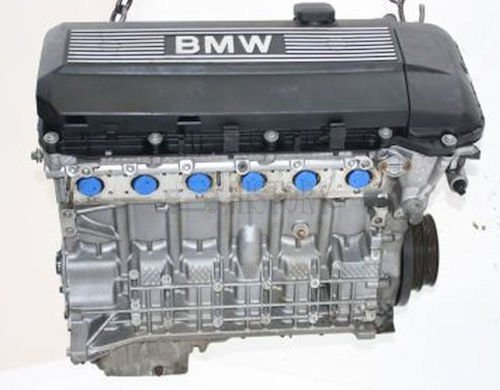
A 1,991 cc (121 cu in) version was introduced in 1994. Bore is 80 mm (3.1 in) and stroke is 66 mm (2.6 in).
Applications:
- 1994-1998 E36 320i
- 1995-1998 E39 520i
M52TUB20
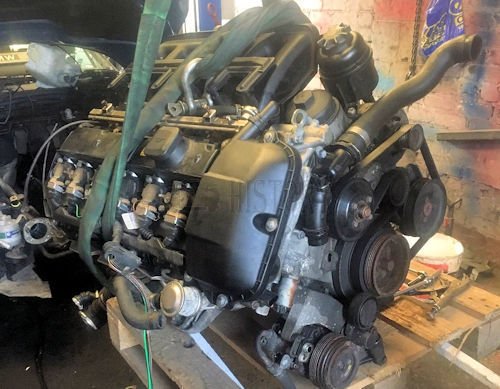
The "technical update" in 1998 included dual VANOS, which improved low rpm torque.
Applications:
- 1998-2000 E46 320i, 320Ci
- 1998-2000 E39 520i
- 1999-2000 E36/7 Z3 2.0i
M52TUB24
2.4 L. For Thai market only.
M52B25
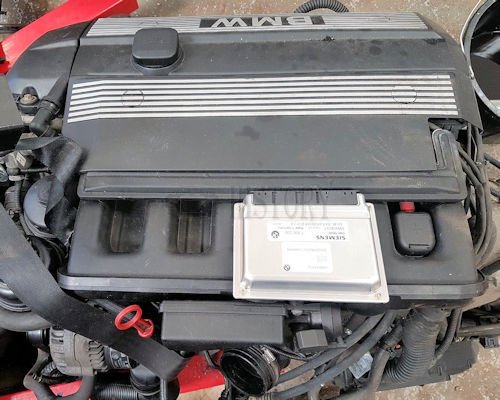
A 2,494 cc (152 cu in) version introduced in 1995. It produces 125 kW (168 hp). Bore is 84 mm (3.3 in) and stroke 75 mm (3.0 in).
Applications:
- 1995-1998 E36 323i,
- 1995-2000 E36/5 323ti
- 1995-2000 E39 523i
M52TUB25
The "technical update" in 1998 included dual VANOS, which improved low rpm torque.
Applications:
- 1998-2000 E46 323i, 323ci, 325i
- 1998-2000 E39 523i
- 1998-2000 E36/7 Z3 2.3i
M52B28
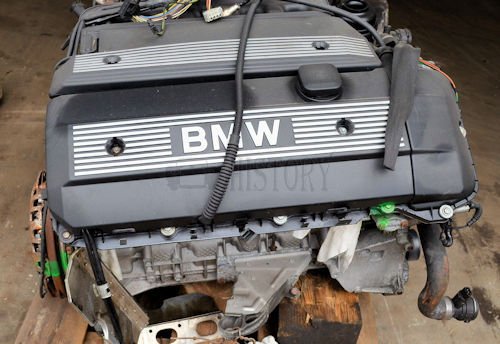
The 2,793 cc (170 cu in) version of the M52 debuted in 1995. It has a bore of 84 mm (3.3 in), a stroke of 84 mm (3.3 in) and produces 142 kW (190 hp).
Applications:
- 1995-1998 E36 328i, 328is
- 1995-1998 E39 528i
- 1995-1998 E38 728i, 728iL
- 1997-1998 E36/7 Z3 2.8
- 1997-2000 Land Rover Defender (South Africa only)
M52TUB28
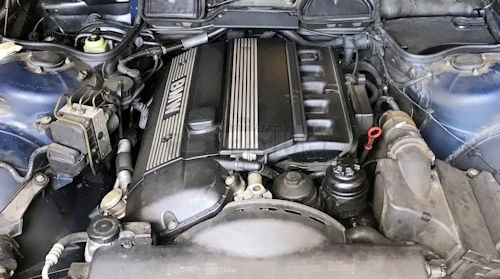
The "technical update" in 1998 included dual VANOS, which improved low rpm torque.
Applications:
- 1998-2000 E46 328i, 328Ci
- 1998-2000 E36/7/8 Z3 2.8
- 1998-2000 E39 528i
- 1998-2000 E38 728i
Nikasil problems with high sulfur fuels
The aluminum M52 engine received criticism in some markets with high levels of sulfur in the petrol during the late 1990s. Sulfur has a corrosive effect on Nikasil and led to many early M52 and M60 engines having premature bore-liner wear. In the USA, the M52 used an iron block (except for the M52B28 in the Z3 which was an aluminum block), so the Nikasil problem does not apply to most M52 engines in the USA.
The eventual fix for engines destined for high-sulfur gasoline markets was revised cylinder liners in the aluminum block. With the exception of the cylinder liners, the basic aluminum block of the M52 engine was the same for all markets.
M52TU engines (which use an aluminium block in all markets) use revised cylinder liners, so are not affected by the Nikasil problem.
For the market launch of the BMW E46 (in February 1998) the M52 was technically revised (TÜ = technically revised). Among other things, these engines featured twin Vanos (except in the E36 Compact from 2/1999 - 2000, where the single vanos were retained) and additional catalytic converters in the exhaust manifolds. From September 1998, the technically revised version was also installed in the BMW E39. The engines were replaced by the BMW M54 .
S52
The S52 is a higher performance version of the M52 which used for the post-facelift (1996-1999) North American E36 M3, replacing the S50B30US.
Basically based on the M52, but with cast iron block, the sports engine S52B32 / US was developed as a successor to the BMW S50B30 / US . The BMW S52B32 / US had (in contrast to the European BMW sports engines) no single throttle valve injection and no further optimizations and only one intake VANOS . It was used exclusively in the US versions of the BMW E36 M3 , the BMW E36 / 7M Roadster and the BMW E36 / 8 M Coupe . He also served as the basis (block) for the Alpina B3.3 and B3.4 based on the BMW E46.
Compared to the S50 engine used elsewhere, the S52 is less powerful and features more in common with the regular M52 engine. As per the North American M52 engine, the S52 uses an iron block, aluminium head and single VANOS. Unique to the S52 is a bore of 86.4 mm (3.4 in) and stroke of 89.6 mm (3.5 in) for a total displacement of 3,152 cc. The engine is rated at 240 hp (179 kW) at 6,000 rpm and 236 lb·ft (320 N·m) of torque at 3,800 rpm.
Other upgrades over the M52 include lighter camshafts with more lift and duration, piston rings, valve springs and the exhaust system.
Applications:
- 1996-1999 E36 M3 (Canada and USA only)
- 1998-2000 E36/7/8 Z3M (Canada and USA only)
Technical
-
BMW 3 Series (E36) 2,0 320i 110 kw (149hp)
Below also For 3 and 5 series 2.0,2.5 and 2.8 unless stated*
No. of cylinders 6/DOHC Capacity 1991 cc
Compression ratio 11.0:1
Ignition coil Bosch Type 0 221 504 410
Firing order 1-5-3-6-2-4
Distributor Bosch 0 261 200 403
Starter motor Bosch Type 0 001 108 115
Alternator Bosch Type 0 120 469 967*BMW 3 Series (E36) 2,5 323i Output: 125kw (170hp)
No. of cylinders 6/DOHC Capacity 2494 cc
Compression ratio 10.5:1
Ignition system Make Siemens Type Motronic MS41.0
Thermostat opens 92°C*BMW 3 Series (E36) 2,8 328i
No. of cylinders 6/DOHC Capacity 2793 cc
Compression ratio 10,2:1
Ignition system Siemens Type Motronic MS41.0
Thermostat opens 92 °C© Motor car
